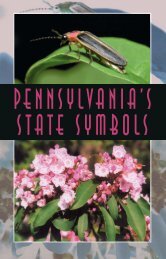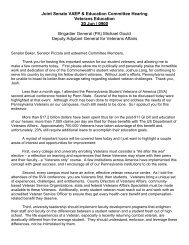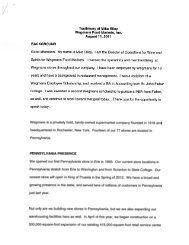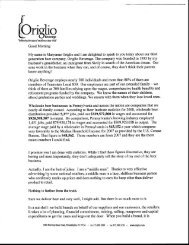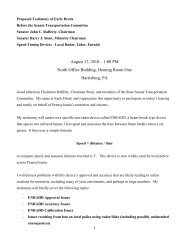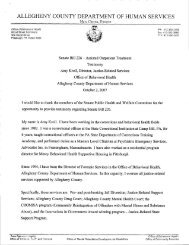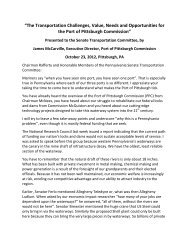Presentation
Presentation
Presentation
Create successful ePaper yourself
Turn your PDF publications into a flip-book with our unique Google optimized e-Paper software.
Wild Trout• 58 Pa. Code § 57.11. Listing of wild trout streams.(a) Maintenance of list. It is the policy of the Commission toaccurately identify and classify streams supporting naturallyreproducing populations of trout as wild trout streams. TheFisheries Management Division will maintain the list of wild troutstreams. The Executive Director, with the approval of theCommission, will from time-to-time publish the list of wild troutstreams in the Pennsylvania Bulletin and on the World Wide Web.Persons with comments, objections or suggestions about theclassification of streams listed may submit them to theCommission for review.
Criteria: Location and Habitat
Criteria: Exclusion of stocked trout
Biological Criteria:• Young of the yeartrout less than 150mm occur at sometime in the streamsection.• Two or more agesof wild trout occurat some timewithin the streamsection.
Criteria: Tributary Linkages• Tributaries to wild trout streams are classified as wildtrout streams for their function as habitat forsegments of wild trout populations, includingnurseries and refuges, and in sustaining waterquality necessary for wild trout.
Wild Trout determinedby tributary linkageWild Troutdeterminedfrom streamsurvey
Criteria: Existing Use• The streams identified as wild trout streams on orbefore January 1, 2002, and listed as such by theFisheries Management Division will continue to beconsidered as wild trout streams by the Commission
Wild Trout Streams and DEP• 25 PA Code Chapter 105: Dam Safety and WaterwayManagement• Wild trout streams—A stream identified as supportingnaturally reproducing trout populations by the Fish andBoat Commission under 58 Pa. Code § 57.11 (relatingto listing of wild trout streams).
Wild trout and DEP (cont.)• § 105.17(1)(iii) – Exceptional Value Wetlands• Includes ―Wetlands that are located in or along thefloodplain of a wild trout stream . . . and the floodplainof streams tributary thereto‖• Results in higher level of protection
PFBC Wild Trout Classification• Based on Biomass (kg/ha)• Class A• Class B• Class C• Class D• Class E
Class A Wild Trout Waters Program
§ 57.8a. Class A Wild Trout StreamsIt is the policy of the Commission to manage selfsustainingClass A wild trout populations as a renewablenatural resource to conserve that resource and theangling it provides. Class A wild trout populationsrepresent the best of the Commonwealth’s naturallyreproducing trout fisheries. These stream sections aremanaged solely for the perpetuation of the wild troutfishery with no stocking.
GoalTo provide recreational trout angling opportunities inwaters where wild trout populations are capable ofsupporting a sport fishery without stocking
Objectives:• To protect wild trout populations from possible harmfuleffects of stocking due to competition with hatchery trout• To minimize the potential of over harvest of wild trout dueto attraction of large numbers of anglers through stocking• To maintain standing stocks of wild trout at a Class Abiomass density• To protect habitat and water quality through publiceducation and by seeking the highest DEP Water QualityStandards applicable
Class A Wild Brook Trout Criteria• Total wild brook trout biomassof at least 30 kg/ha• Total biomass of brook trout
Class A Wild Brown Trout Criteria• Total wild brown trout biomassof at least 40 kg/ha• Total biomass of brown trout
Class A Mixed Wild Brook & Brown Trout WatersCriteria• Combined wild brook andbrown trout biomass of at least40 kg/ha• Total biomass of brook trout
Class A Wild Rainbow Trout Criteria• Total biomass of wildrainbow trout < 15 cm (5.9inches) of at least 2.0kg/ha
Class A Wild Trout Waters SummarySpecies Stream Sections MilesBrook Trout 274 743.6Brown Trout 163 507.3Mixed Brook andBrown Trout62 211.0Rainbow Trout 11 28.7Total 510 1,490.6
Statewide distribution of Class AWild Trout Streams
Class A and DEP
Existing Use• An ―existing use‖ is defined in Title 25 Pa. CodeSection 93.1 as “Those uses actually attained inthe waterbody on or after November 28, 1975,whether or not they are included in the waterquality standards.”
Class A and Existing Use• Section 93.4b(a)(2)(ii) provides that a waterbody“…that has been designated a Class A wild troutstream by the Fish and Boat Commissionfollowing public notice and comment.” is an HQwater.
Existing Use Protection for Class A Wild Trout Streams• DEP will review all data submitted to it by the PFBC and others regarding theClass A wild trout stream status of a stream. If, upon DEP review, DEP findsthat:(1) the waterbody has been designated by the PFBC as a Class A wild troutstream;(2) the PFBC designation has been adequately publicly participated, withprovisions for public notice and comment; and(3) BWSWM (now Bureau of Water Standards and Facilities Management)has reviewed the fishery data and the Director concurs with theclassification, DEP will place the water on the existing use list with anexisting use of HQ waters.
Class B, C, D,and E Streams
Class B-E Wild Trout CriteriaClassCriteriaB a. Total wild brook trout biomass of at least 20kg/ha (17.8 lbs/acre) and less than 30 kg/ha(26.7 lbs/ acre).b. Total wild brown trout or wild brown and wildbrook trout combined biomass of at least 20kg/ha (17.8 lbs/ acre) and less than 40 kg/ha(35.6 lbs/acre).C Total wild trout biomass of at least 10 kg/ha (8.9lbs/ acre) and less than 20 kg/ha (17.8 lbs/acre).DETotal wild trout biomass greater than 0 kg/ha andless than 10 kg/ha (8.9 lbs/ acre).Total wild trout biomass of 0 kg/ha.
DEP Chapter 93 Criteria for Class B-E streams• EV – for criteria other than Class A• HQ – for criteria other that Class A• CWF• TSF – No wild trout, but stocked
PFBC Wild Trout Classification and theSusquehanna River Basin CommissionSRBC Policy No. 2003-01• GUIDELINES FOR USING AND DETERMININGPASSBY FLOWS AND CONSERVATIONRELEASES FOR SURFACE-WATER ANDGROUND-WATER WITHDRAWAL APPROVALS(NOVEMBER 8, 2002)
Passby Flow• A passby flow is a prescribed quantity of flow thatmust be allowed to pass a prescribed pointdownstream from a water supply intake at any timeduring which a withdrawal is occurring. When thenatural flow is equal to, or less than, the prescribedpassby flow, no water may be withdrawn from thewater source, and the entire natural flow shall beallowed to pass the point of withdrawal. Natural flowin the stream channel below the point of withdrawalis maintained at the same level as may prevail above
Conservation Release• An amount of water required to pass downstream ofa reservoir
Instream Habitat Loss associated with WaterWithdrawals• EV – 5%• High Quality (HQ) Waters—Withdrawals may not cause greater thana 5 percent loss of habitat; except a habitat loss of 7.5 percent maybe allowed if the following conditions are met:• The project is in compliance with the Commission’s waterconservation regulations of Section 804.20;• No feasible alternative source is available; and• Available project sources are used in a program of conjunctiveuse approved by the Commission, and combined alternativeproject source yields are inadequate.
• Cold-Water Fishery (CWF) Waters:• PFBC Class B Wild Trout Streams—Withdrawals may not cause greater than a 10percent loss of habitat.• PFBC Class C or D Wild Trout Streamstandards— Withdrawals may not causegreater than a 15 percent loss of habitat.
DEP water withdrawal regulation• Is generally following SRBC policy in their waterwithdrawal permitting for municipal water supplies• Application to Marcellus fracing and WaterManagement Plans in oil and gas permits
How is Habitat Loss Determined ?SRBC Publication 191, Instream Flow StudiesPennsylvania and Maryland (May 1998)• Used to determine instream habitat loss for wild troutbased on given withdrawal and passby amounts
SRBC, DEP, Pennsylvania Fish and BoatCommission, U.S. Army Corps ofEngineers, Maryland Department of theEnvironment and the Chesapeake BayProgram
Components of IFIMHydraulicModelDevelopmentBiologicalModelDevelopment(HSC’s)HabitatModelDevelopmentImpact Assessment
W UA(ft2/1000 ft of Stream)Habitat Model DevelopmentW UA vs Q, Brook Trout, G reen Creek Seg. 1400035003000250020001500WU A AdultWU A JuvenileWU A Spaw ningWU A Fry100050000 50 100 150 200Q(% ADF)
Wilderness Trout Streams• § 57.4. Wilderness trout streams.• It is the policy of the Commission to maintain thewilderness trout streams program where streamremoteness and populations of naturally reproducingtrout combine to offer sport fishing opportunity for therecreation of anglers in a wilderness setting away fromroads or vehicular access. It is the Commission’sintent to advocate proper watershed management tomaintain the wilderness setting and to advance andseek the highest water quality standards through theDepartment of Environmental Protection.
Wilderness Trout Criteria• Accessible to motorized vehicles to at most onepoint every two miles• At least two miles in length• Natural reproduction sufficient to support a sportfishery• Open to the general public
• Program initiated in 1969Overview• 31 Class A stream sections• 177 Class B, C, and D stream sections have been sodesignated.• Protection is achieved through the application of thehighest DEP water quality classification (EV) and theprohibition of stocking.
25 Pa.Code Chapter 93.4(b)(b)• ― A surface water that meets one or more of thefollowing conditions is an Exceptional Value Water.• (1) The water meets the requirements of subsection(a) (qualification as an HQ water) and one or more ofthe following: . . . Qualification as a Wilderness TroutStream
Approved Trout Streams – Streams approved forstocking by the PFBC• Various Chapter 93 criteria apply:• HQ – for criteria other that Class A• CWF – could be a wild trout stream, but stocked• TSF – No wild trout
High Quality-Warm Water Fishes
HQ-WWF• Currently no fish population criteria for this class ofstreams• PFBC Strategic Plan• By January 2013, develop and advocate for waterquality protection criteria for special protection classesof Warm Water Fishes in 25 Pa. Code Chapter 93 incollaboration with the Pennsylvania Department ofEnvironmental Protection• PFBC staff are currently working on this with DEP
ProblemMany waters in Pennsylvania havenever been surveyed by the PFBC
Robert WeberPA Fish and BoatCommissionFisheries BiologistFish Management Division
Pennsylvania’s Flowing WaterResources- Surveyed Stream Sections - Unassessed Stream Sections
Pennsylvania’s Flowing Water Resource• PA estimated to contain 86,000 miles of flowingwater.• Approximately 22,000 miles have been sampled• To date, 12,800 miles designated as wild troutwaters
Strategic Plan for Management of Trout Fisheriesin Pennsylvania2010 - 2014Issue 1: The PFBC has not assessed all of the streamsthroughout the Commonwealth. As a result, the totalnumber of streams that support wild trout populations inPennsylvania is unknown, which leads to inadequateprotection for these streams. The PFBC does notcurrently have the ability to assess these most at-riskstreams at a rate that outpaces the rate of degradation.
Goal:Proactively identify and properly classifythe most at-risk streams which supportnaturally reproducing trout populations inorder to protect, conserve and enhancethose waters as wild trout streams.
Strategy:• Utilize GIS technology to identify potential wildtrout streams (watersheds) most at risk.
Unassessed Waters Initiative – 2011 PriorityWatersheds
2010 Activities1. PFBC biologists sampling2. Developed and implemented pilot program withcontracted Universities3. Enlisted cooperation of DEP biologists4. Sampled 307 Unassessed waters
307 Unassessed Waters Sampled in2010Sampling Conducted by:Fisheries Management Division, Environmental Services Division, DEP, LycomingCollege and Kings College.
Unassessed Waters Sampled in2010Permited and /or Active Marcellus Gas DrillingSites
From the 307 Unassessed Waters Sampledin 2010:• 241 waters sampled by PFBC and DEP staffs(79%).• 66 waters sampled by Lycoming College andKings College (21%).
Additions/Modifications to 2011 WildTrout List• 99 New waters have been proposed for addition to the wild troutlist.• 78 of the 99 new waters from 2010 unassessed waters workwhile 21 from previous surveys.• 8 waters proposed to have their wild trout limits changed (7extensions, 1 reduction)• 3 waters approved for Class A Wild Trout managementdocumented via unassessed waters work in 2010.
Additions/Modifications to 2011 Wild Trout ListProposed New Additions to Wild TroutListProposed Updated Waters to Wild TroutList
Summary• PFBC staff exceeded the 5-year goal of 200 surveys during thefirst year of the program.• Pilot project with contracted Universities was successful on alllevels.• Interest in the Unassessed Waters Initiative continues to growamong academic groups, conservation groups and organizedsportsmen’s groups.
Future Initiatives of the Program• Number of contracted ―entities‖ will expand in 2011. SevenUniversities and 2 Conservation Organizations.• Obtain long-term funding source(s).• DEP regional biologists have agreed to participate in theprogram as a partner. Training for their staff completed inFebruary.• Will be working with Sportsmen’s groups to develop additionalpartnerships.
Questions?



